5th July - 12th June, 2004
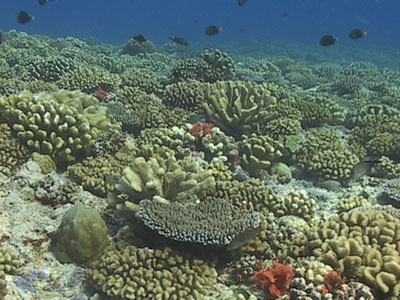
Barrier reef
25°C
2.2% of area studied shown to be affected by bleaching
There were no visible signs of disease.
25 meters vertically from the surface
None observed.
Bora Bora is known for having the most beautiful lagoon in the world. The turquoise lagoon surrounds a lush, volcanic island, with three main peaks, Mt. Hue (619m), Mt. Pahia (661m), and Mt. Otemanu (727m). Around the perimeter of the lagoon, are a series of motus (small islands). On the outside of the lagoon, a barrier reef lines the motus protecting the lagoon from the harsh weather of the open sea. Bora Bora is the second most popular tourist destination in the Society Islands after Tahiti, and it shows. More hotels are being built every year, and as we arrived, no less than three new hotels were in the process of being erected. Although the population of Bora Bora is about 7,700, the inflow of tourists significantly increases the number of people on Bora Bora year round. The main town of Vaitape is usually relaxed and slow-paced with a market, a few snack cafes, pearl shops and souvenior stores. During the Heiva, a big month long festival which takes place throughout June and July each year, Vaitape becomes lively and full of people. Every night hundreds of locals and foreigners gather to watch traditional Tahitian singing and dancing.
The coral structure of Bora Bora varies with location. Inside the lagoon consists of mostly Porites and Pavona bommies scattered throughout large patches of sand. Many of the coral bommies we observed in the lagoon were dead due to a cyclone event, some with new growth of Acropora or Porites. Our study was conducted outside the lagoon on the Northern side of Teavanui Pass. The reef here was extremely healthy with relatively high levels of coral diversity and good fish biodiversity/populations. There was very little bleaching, invertebrate overgrowth, or sedimentation. The unhealthy coral colonies observed were mostly affected by algal mat smothering. Percent cover of coral colonies along the reef varied slightly, but was overall very high. Percent cover increased steadily from the corner of the pass along the motu. There were not very many invertebrates observed along the reef, but there were some coral crabs inside Pocillopora colonies, encrusting sponges, and a few featherduster worms.
Between the 3rd and 6th January, 2002, the entire south barrier reef of Bora Bora was killed by a red tide. This is an 18km length of reef, 80 metres wide. There were many factors contributing to this event. The sewage system in Bora Bora is not yet able to cope with the amount of wastewater being produced on the island, especially after heavy rains (although they are building a second treatment plant to cope with increasing amounts of waste water). When the system can no longer cope, the hotels etc. instead dump their waste directly into the lagoon. In December 2001, there was a great deal of rain, and wastewater was dumped in the lagoon. A north wind then lowered the sea-level inside the lagoon. The water temperature rose to 35-36°C. Phytoplankton bloomed, including the dinoflagellate, Gymnodium breve, the major component of a red tide. Then the zooplankton population exploded, consuming all the oxygen in the water and creating such high turbidity that there was practically no light reaching the bottom – visibility was zero. As a result, any organism requiring oxygen died. Millions of dead fish washed up on the beach, creating a horrendous smell. After the red tide was broken up by the swells, the corals looked almost normal, but on close inspection you could see that their live tissue was peeling off from their skeleton. A week later the water was completely clear – tourists arriving for their holidays had no idea that anything had happened at all. But one of the areas affected in the south east corner of the lagoon was the famous ‘coral garden’ snorkeling site. 75-80% of that reef died. Denis Schneider, working with ICRI (International Coral Reef Initiative) has been conducting Reefcheck surveys at ten stations along this stretch of the barrier reef since September 2002. 9 months to a year ago there was a population explosion in the long-spined sea urchin, Diadema. They have found between 450 and 700 diadema in a 5x20m area. This is a disaster for the recovery of this reef since sea urchins are ominivorous and include coral larvae in their diet. Denis has also fixed 10cm x 10cm squares to the reef here to monitor for coral larvae recruitment. In a year and a half, there has been no recruitment in these sites along the 18km of damaged reef which is why he wants to transplant corals here himself.
Cyclones Bora Bora is hit by a cyclone approximately every 7 years, in tandem with El Niño events. There is a definite pattern between cyclone occurrences and the incidence of ciguatera in fish species afterwards. The cyclone acts like a giant washing machine in the lagoon – the last one breaking corals as deep as 56 metres.
Bleaching waves used to come once a year - now they are occurring three times a year leaving the corals very little chance to recover in between. The raised water temperatures last for a week to ten days. In May 2003, 60% of corals bleached.
Spawning events cannot be predicted here, compared with the Great Barrier Reef in Australia. Spawning can occur three times a year. Acropora spawns mainly in September but it is not a very clearly defined event.
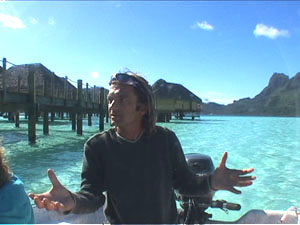
Denis Schneider has seen great changes to the reefs of Bora Bora. He talks of taking local school children on a field trip on a Tuesday and seeing with them a large pristine tabulate Acropora colony, then returning on the Thursday to find it smashed by small boat anchors. He has been working as a ‘landscape scientist’ with three hotels inside the lagoon of Bora Bora (Pearl Beach Resort, Bora Bora Lagoon Resort, InterContinenal Resort) to create artificial reefs beneath the bungalows that stand over the shallow lagoon water. These bungalows have a section of glass floor, looking down to the lagoon below – this is where he plants his reefs. He chooses to work with hotels for many reasons, the major one being that they are the only places in French Polynesia that are relatively protected - there are no marine parks here (apart from the Biosphere Reserve in the Tuamotus).
Passages between the motus from the open ocean into the lagoon are called hoa in Tahitian. Here currents are very strong and pretty constant, bringing clear water into the lagoon but many corals eventually succumb to the almost continuous movement of water and tumble from their substrate. They end up with their ‘heads in the sand’. Corals are also broken on reefs around the lagoon by fishermen, working mostly at night. These are the sources of corals that Denis then ‘transplants’ to his artificial reefs. He places them in crates that he attaches to the underside of his boat so that they do not leave the sea-water, and transports them to his artificial reefs at the resorts. He uses a cement to secure the corals onto ferrocement substrate structures that he builds in his garden. The fixing cement dries within 8 hours.
If these corals do not survive long-term, Denis is at least hoping that they will survive until their next spawning event and so contribute to the future of the reefs.
He is seeing very positive results. A standard growth rate for Acropora is 15cm a year – Denis has recorded 7-8 cm/year growth under bungalows. But Acropora also bleaches the most rapidly and Denis has lost 40% of his reefs in the past due to increased water temperature. As a result, he has practically stopped working with Acropora and Pocillopora because they are too sensitive to temperature change. He has much better results with Montipora, Porites, Psammacora, Leptoseris and Pavona. He also now moves his corals to deeper parts of the lagoon when bleaching events are occurring.
Many fish arrive at these reefs by themselves – we saw moray eels and octopus octopus holes at the Intercontinental Resort. He is working with a team of scientists here in Bora Bora to release 1,500 fish post-larvae (mostly surgeonfish, parrotfish, butterflyfish) into his Pearl Beach Resort reefs at the beginning of next month. He hopes to vastly increase the fish populations and biodiversity.
One of his major problems is a certain demoiselle fish, Pterogliphidodon lacrimatus, which is so fiercely territorial that the usual ‘grazers’ – the herbivorous parrotfish, surgeonfish – cannot perform their normal function on the reef which is to keep algae levels down. There seems to be an abnormally high population of these demoiselles and it is obvious, even from a distance, which corals they have made their home. There will never be any recruitment of larvae on these corals because they are so smothered in filamentous algae and sand. This fish is also now forming schooling populations on the barrier reef. Denis is contemplating various methods for population control of this fish.
He now wants to start applying this reef-building process in the ‘wild’, especially on the southern reef that was so badly damaged by the 2002 red tide. He needs to create a protected area and has a site in mind on the south west corner of the barrier reef – a one hundred metre length of reef to plant corals on.
He also recognizes the need to educate – both the islanders of Bora Bora and the guests at the hotels where he has reefs. For example, housekeepers find corals removed from his reefs beneath bungalows and lying dead inside the bungalows when the guests check out – they were contemplating bringing the coral home as a souvenir but then discovered it was a bit too smelly to put in their luggage. They also stand on the reefs to have their photo taken from the bungalow above. He has begun to introduce long spined sea urchins to the reefs to discourage any contact with them – ‘they make good guard dogs’ he says.
The creation of these artificial reefs is a major deal – you do not just plant a garden on the land and walk away from it, and so too with a hand-made coral garden. It requires maintenance, cleaning, attention. In a one metre diameter reef he has about 15-18 colonies, each about 12-15 cm in diameter. When the temperature increases, about 5 colonies die on average. Algae overgrow these colonies very fast which is potentially the beginning of the death of the reef. If there is no attention given to the reef at this very critical moment, the reef will die. One needs to work fast to remove the affected colonies and replace them. The very shallow waters and the harsh conditions of a Bora Bora summer demand on-going maintenance to keep these reefs alive.
Denis took us on a tour of the lagoon to the three resorts where he currently has projects.
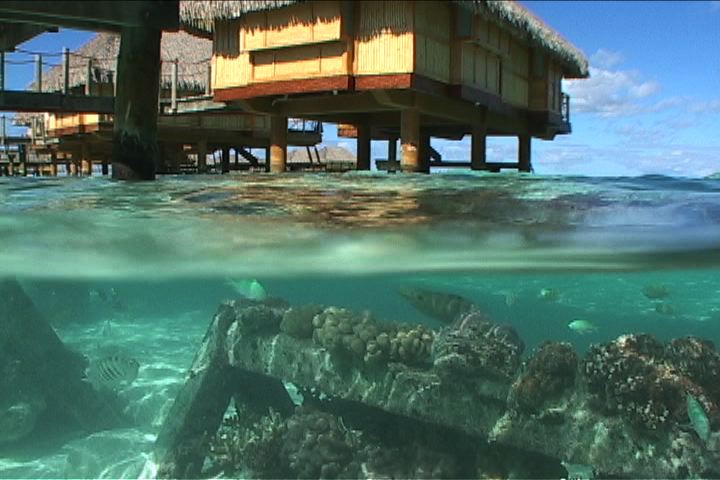
At the Pearl Beach Resort (Tahitian owner), there are 50 over water bungalows and 30 of them now have reefs underneath. Underneath the walkways over the lagoon, he has laid triangular shaped strips of concrete to act as nursery beds for sick corals before he moves them to the reefs under the bungalows.
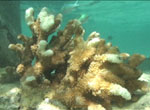
We saw here many corals that had fully recovered from their affliction – eg. A Pocillopora colony that had been 80% bleached which was now 95% coloured again. He showed us how he cleans the corals to remove sediment, how he cleans the pillars that support the bungalows to encourage larval recruitment here. His reefs here are healthy and there are plenty of fish that have arrived here of their own accord, although he has a big problem with the territorial demoiselle here. He showed us the sections of reefs that they are guarding possessively. He has free reign to work under the bungalows here although the owner had told him to not let the reefs extend into the lagoon – the aerial photo of the bungalows standing over clear turquoise water is what sells the rooms.
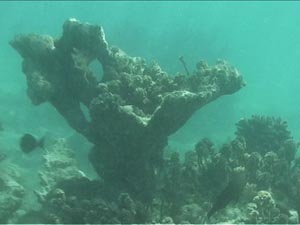
At the Bora Bora Lagoon Resort (Orient Express), it is a very different story. The hotel was built in 1991, with bungalows on concrete pillars that were driven through the substrate plate of the fringing reef around Toopua Island. There have been six cyclones since the hotel was built – each of them taking their toll on the hotel but even more on the reef. We found almost the entire naturally occurring fringing reef dead – the only living corals (except for a few hardy Porites lobata colonies) are those that Denis has planted there on circular cement plates. This was a devastating sight. The management group are now planning to spend up to a quarter of a million US $ to bring heavier sand to their patch of lagoon to increase the aesthetics of the surrounding waters. Yet they are only offering $30,000 to clean up the coral rubble that they have created, and are showing no signs of committing to reintroducing and maintaining corals on a long-term basis. The bungalows here are in a shocking state – the cement pillars holding them up are crumbling and we found large piles of cement fragments that have just been piled up in the water beneath the bungalows.
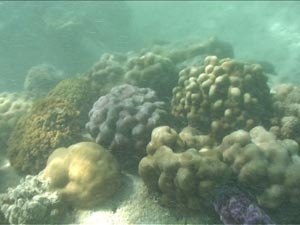
At the Intercontinental Resort, we found again healthy reefs but witnessed a continuing problem with shifting sands. The plates on which Denis has planted his corals are constantly sinking into the sand – the bottom levels are constantly changing, creating hollows where it was flat before. Again, these artificial reefs need to be taken care of which requires manpower to make necessary adjustments to the reef-plate positions and attention on the amount of sedimentation on the corals. He showed us corals that have recently been unearthed from the sand and they are, of course, dying.
In theory there are regulations concerning the construction of hotel bungalows in the lagoon – only 40% of the bungalows are allowed to be on water with the other 60% to be built on the land. But the regulations are not being strictly adhered to. There are some environmental regulations in place in French Polynesia but not a single one of them protects live corals.
Complex financial regulations do not help to control the amount of construction in the lagoon. There are three major hotel complexes being built right now by InterContinental, RitzCarlton and Four Seasons. New projects are not obliged to make any profit for their first five years – they are subsidized.
There is a population increase in Bora Bora – 6,000 people ten years ago has increased to 7,700 today. The Tahitians are no longer able to carry out their traditional management plan of the reefs – ra’ui by which they fish certain areas for half the year and then leave them to rest for the other half. Because of the ever-expanding use of reef and lagoon for resorts, their choices of fishing sites are reduced.
A channel has been carved through the north east side of the barrier reef to encourage an increase in the flow of clear ocean water into the lagoon. This of course will have an effect on wave patterns and shifts in sedimentation but it is an attempt to increase the quality of the lagoon’s water. And the waters of Bora Bora Lagoon are remarkably clear. We found dream-like turquoise lagoon almost all the way around the east side of the main island. We also found new coral life around the dock at Vaitape – the main ‘town’ on the island.
False advertising could ruin Bora Bora – hotel groups are clearly not thinking long term and very few appear to have any intention of committing to the future of the lagoon. Tourists themselves don’t complain because they are on a two week break from high stress – they don’t want any aggravation in their time off. And the hotels don’t ask the tourists how they have enjoyed their experiences in the water – ‘when we don’t like the answers, we don’t ask the questions’. The kind of tourists that can afford to come to Bora Bora are high-class world travelers who have experiences in the Red Sea, the Indian Ocean etc. When Denis does get the chance to speak to them directly, he finds them to be very disappointed with what they have found in the lagoon, especially at the Bora Bora Lagoon Resort.
Bora Bora is ranked as one of the top ten tourist destinations in the world and with very good reason. It is one of the most aesthetic islands we have ever seen in the South Pacific – and it has a huge amount to offer. But right now it stands on a threshold where choices can be made to either maintain and improve on the natural resources it already has, or to neglect the work it will take to preserve this beauty and allow the state of the island, the lagoon and the reefs to deteriorate. There is a potential disaster ahead but this is not a battle lost – far from it.
There is a season in October-November when many turtles gather near the airport inside the lagoon. At this time, there are up to 40 boats out fishing for turtles, with each boat catching up to 20 turtles in a day. It is now, in theory, illegal to eat turtle meat in Bora Bora but there is a black market on the island with turtles being carved up and dispatched immediately for consumption. They are also now flying excess turtle meat to Papeete, Tahiti. The turtle has for centuries been a food of the kings of French Polynesia – he would eat just the head and the tail then pass the rest of it to the class below him for consumption.
There are two predominant species of turtle here – the green turtle which is edible and the hawksbill turtle which is poisonous so they do not eat it. However, the spearfishermen use it for target practice so there are many unnecessarily injured hawksbills.